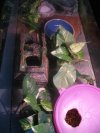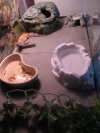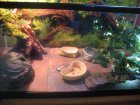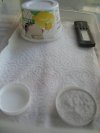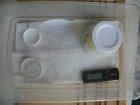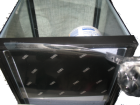Care Sheet----------------------- HousingA ten gallon tank is adequate for housing one or two geckos, though it is fun to give them different hide areas, or even develop a natural vivarium. Leopard geckos do not climb glass, however it is best to have a screen top for their own safety. This is also important if you are feeding crickets! Female geckos of approximately the same size can be housed together. At times one can become more aggressive, preventing the other from eating. In this case separate the geckos to reduce stress and allow both to receive the food and shelter needed to thrive. Males are extremely territorial and can not be housed together. ----------------------- Hide BoxesHide boxes can come in a variety of forms. They can be as simple as a Tupperware container with a hole cut in the side or a toilet paper roll. You can find more natural looking hide boxes at most pet stores. These come in rock formations, caves and the sort. You can also find more interesting themes by searching the fish hide decorations at a pet store. Many of our tanks are set up with sunken pirate ships, skulls and greek ruins. Be sure to include two hide boxes in your set up. One hide should be placed on the cooler side of the tank, while a moist hide should be placed on the warmer side. Wet paper towels, or peat moss purchased from a pet store, can be used inside the hidebox for moisture. This moisture is extremely important as it helps the gecko while shedding. It is not uncommon to have a gecko loose digits due to lack of moisture. ----------------------- SubstratesMany things can be used as a substrate for the adult gecko. Common things are play sand, tiles, linoleum, and paper towels. Calcium sand is never recommended for leopard geckos! The best thing to use for juveniles is paper towels. Young geckos often eat the sand that is in the cage as they are trying to catch their food. This can result in them becoming impacted which will send you on an emergency trip to the vet, or even worse, loosing your lizard. Paper towels are also inexpensive and make clean up a bit easier! ----------------------- HeatingYour leopard gecko will require gradient heating. This allows them to move around the tank to find a place to warm up or to cool off. This can be achieved by using an Under Tank Heater (UTH). The surface temperature of the warm side of the cage should be around 90 degrees while the cooler side should be room temperature (70-76). If you are having difficulty with the warm temperature of the UTH, a lamp dimmer can help adjust the temperature. You can also purchase thermostates that will control the UTH for a consistent temperature. I do not recommend heat rocks that are sold for reptiles. They easily become much too hot, which can bake the underside of your lizard! ----------------------- LightingLeopard geckos are primarily nocturnal and do not require special lighting. Of course there is no harm in providing UV lighting. I do recommend using a blue or red light at night for viewing. Because leopard geckos are nocturnal, their eyes are sensitive to bright light. ----------------------- FeedingAdult leopard geckos should be offered food every other day, while juveniles should be fed daily. Your lizard should also have access to water. I also keep a small dish of vitamin/calcium in their tank to help aid with nutrition. The big question is what to feed them! Meal worms are perhaps the easiest, though I have noticed that the geckos are sometimes bored with them. Other options are crickets, waxworms, roach nymphs, and pinkie mice (for adults only). Wax worms should be only offered occasionally as they are really the junk food of the lizard world. Crickets have a few difficulties as well, though it is a lot of fun to watch your gecko hunt! Crickets can not be left in the tank uneaten, they will bite at the geckos which will likely cause them to become stressed and quit eating. As a rule geckos can eat items ¾ of their head size. We use meal worms and roach nymphs and pinkie mice for the egg laying females. Meal worms and roach nymphs both offer easy feeding, and if put in a smooth edge container, they do not crawl around the cage and through the lizard feces causing problems. (Roaches also do not escape, bite geckos, or smell terrible!) The most important part of feeding, no matter what you choose, is gut loading and dusting. ----------------------- Getting Started Checklist
Remember that setting up a home for your gecko does not have to be expensive. You can use a plastic sweater box instead of an aquarium. Hide boxes can be found around your home (check the kitchen)! Jar lids are great for calcium. The one purchase I have found that smooth sided feeding dishes extremely useful to avoid escaping insects. They are crafty things when trying to avoid being dinner! |
|||
|
|
||||||||||||||
|
||||||||||||||


